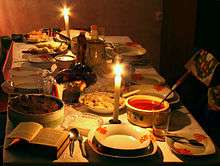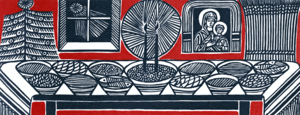Twelve-dish Christmas Eve supper

A twelve-dish Christmas Eve supper is traditionally prepared in many Eastern European and Northern European cultures, especially those that were formerly part of the Polish-Lithuanian Commonwealth, including Polish, Lithuanian and Ukrainian. The meal (Lithuanian: Kūčios, Polish: Wigilia or wieczerza wigilijna, Ukrainian: Свята вечеря, Sviata vecheria) consists of twelve meatless dishes representing the twelve months of the year. The tradition of the supper can be traced back to pre-Christian times and connected with remembrance of the souls of deceased ancestors.
In some parts of Poland a similar tradition of thirteen meatless dishes on Christmas Eve is practiced.
Description
The specific dishes may differ from country to country, but many of them are universal. Due to the Nativity Fast, no meat, eggs or milk (including cheese) are allowed during the supper. Thus fish, mushrooms and various types of grain are the main offerings.
In Poland and Ukraine the supper begins with eating soup. Kutia, poppy milk (aguonų pienas) together with kūčiukai are served as a dessert and forms a significant part of the Lithuanian Christmas Eve menu. Poppy seeds are widely used for Christmas Eve dishes, because they symbolize abundance and prosperity.
Regarding the fish dishes, usually herring, carp or pike are eaten. In Lithuania, herring (Lithuanian: silkė) dishes are rich and variable. Usually silkė su morkomis (herring with carrots), or silkė su grybais (herring with mushrooms) are served on Christmas Eve.
Mushrooms, especially dried or pickled, are also one of the main dishes eaten on Christmas Eve. Sauerkraut (Polish: Kiszona kapusta, Russian: Ква́шеная капу́ста, Kváshyenaya kapústa) with wild mushrooms or peas, red borsch, mushroom or fish soups are eaten in Poland and Ukraine.
Boiled or deep fried dumplings (Polish: pierogi, Ukrainian: вареники, varenyky, Lithuanian:auselės) with a wide variety of fillings (including sweet cabbage, mushrooms and crushed poppy seeds), are among the most popular dishes. Doughnuts filled with jam (Polish:pączki, Ukrainian: пампушки, pampushky) are served for a dessert in Ukraine, but in Lithuania sweet dishes are not common, as they are believed inappropriate for the atmosphere of the evening.

As for beverages, traditionally dried fruit compote or cranberry kisiel (Lithuanian: spanguolių kisielius) are common. In earlier times oaten kisiel was more common.
There is the whole ritual before the meal begins. Once the first star appears on the sky, each member of family washes his face, hands and legs in cold water saying: "Be as healthy as this water is." The most brave people go to local rivers or lakes and have a short swim there. After the water procedure is finished, the family goes on with a prayer, often the Our Father. [1] After the prayer the head of the household will anoint each person present with honey, making the sign of the Cross on their forehead, saying: "In the name of the Father and of the Son and of the Holy Spirit: may you have sweetness and many good things in life and in the new year."
The Christmas Eve supper is usually held under candlelight and starts in the evening after the first star appears in the sky. The star symbolizes the birth of Jesus in Christian tradition and a soul of deceased ancestors in pre-Christian beliefs. Quiet, dim-lighting, and a somewhat mystical atmosphere is characteristic for Christmas Eve supper.
In Poland and Ukraine an extra plate and seat are always left for anyone, such as a drifter, or for deceased loved one to be accepted as a guests.
